Connect With Us
Blog
Items filtered by date: July 2024
Factors for Seniors Seeking Exercise Shoes
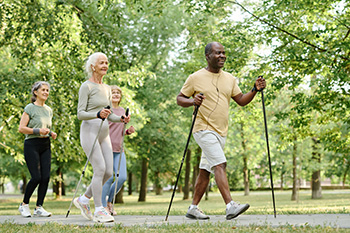
Selecting the right exercise shoes is particularly important for seniors to ensure safety, comfort, and effectiveness during physical activity. Seniors should consider several factors when choosing footwear, such as the type of exercise they plan to do and the level of support required. The wear pattern on current shoes, foot shape, and arch support needs must also be weighed. High-impact activities such as running often call for shoes with more support, while activities like walking may require less. Analyzing the wear on old shoes can provide insights into your gait and help guide your choice. Foot shape and arch support are critical, as some feet have high arches, others are flat, and many fall inward or outward when standing. Exercise shoes should feel comfortable during extended wear and be aesthetically pleasing to encourage regular use. A podiatrist can assess your foot type, gait, and specific needs, in order to recommend the most suitable footwear to prevent injuries and enhance exercise performance. If you are looking for the right exercise shoes, it is suggested that you schedule an appointment with a podiatrist for guidance on options that are best for you to consider.
Proper foot care is something many older adults forget to consider. If you have any concerns about your feet and ankles, contact one of our podiatrists from Sutera and Jones Surgical Podiatry. Our doctors can provide the care you need to keep you pain-free and on your feet.
The Elderly and Their Feet
As we age we start to notice many changes in our body, but the elder population may not notice them right away. Medical conditions may prevent the elderly to take notice of their foot health right away. Poor vision is a lead contributor to not taking action for the elderly.
Common Conditions
- Neuropathy – can reduce feeling in the feet and can hide many life-threatening medical conditions.
- Reduced flexibility – prevents the ability of proper toenail trimming, and foot cleaning. If left untreated, it may lead to further medical issues.
- Foot sores – amongst the older population can be serious before they are discovered. Some of the problematic conditions they may face are:
- Gouging toenails affecting nearby toe
- Shoes that don’t fit properly
- Pressure sores
- Loss of circulation in legs & feet
- Edema & swelling of feet and ankles
Susceptible Infections
Diabetes and poor circulation can cause general loss of sensitivity over the years, turning a simple cut into a serious issue.
If you have any questions please feel free to contact one of our offices located in Media, Glen Mills, Riddle Memorial Hospital, and Concordville, PA . We offer the newest diagnostic and treatment technologies for all your foot and ankle needs.
Manging Osteoarthritis of the Ankle
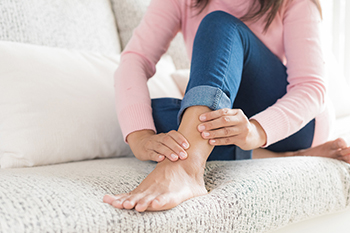
Unlike osteoarthritis in other joints, ankle arthritis typically develops following a previous ankle injury, often years or even decades later, with about 95 percent of cases attributed to past traumas. Excess weight and repetitive high-impact stress further can affect osteoarthritis of the ankle, highlighting the importance of lifestyle modifications and weight management strategies. Ankle cartilage, being half the thickness of knee cartilage, is more susceptible to forces, increasing the risk of osteoarthritis development. Additionally, individuals diagnosed with ankle osteoarthritis are typically younger than those diagnosed with the same condition in other joints. Further, it may progress more rapidly to end-stage disease, potentially affecting other joints as they compensate for ankle instability. Diagnosis often requires advanced imaging techniques, such as MRI scans to accurately assess ligament and cartilage damage. Relief techniques can include low-impact exercise, weight management, supportive footwear, and medications. In severe cases, surgery may be considered. If you are experiencing persistent ankle pain or have a history of ankle injuries, it is suggested that you schedule an appointment with a podiatrist for an accurate diagnosis and personalized treatment options.
Arthritis can be a difficult condition to live with. If you are seeking treatment, contact one of our podiatrists from Sutera and Jones Surgical Podiatry. Our doctors can provide the care you need to keep you pain-free and on your feet.
Arthritic Foot Care
Arthritis is a joint disorder that involves the inflammation of different joints in your body, such as those in your feet. Arthritis is often caused by a degenerative joint disease and causes mild to severe pain in all affected areas. In addition to this, swelling and stiffness in the affected joints can also be a common symptom of arthritis.
In many cases, wearing ill-fitting shoes can worsen the effects and pain of arthritis. Wearing shoes that have a lower heel and extra room can help your feet feel more comfortable. In cases of rheumatoid arthritis, the arch in your foot may become problematic. Buying shoes with proper arch support that contour to your feet can help immensely.
Alleviating Arthritic Pain
- Exercises that stretch the foot can prevent further pain and injury and increase mobility
- Most of the pain can be alleviated with anti-inflammatory drugs, heat, and topical medications
- Massages can help temporarily alleviate pain.
It is best to see your doctor for the treatment that is right for your needs and symptoms. Conditions vary, and a podiatrist can help you determine the right method of care for your feet.
If you have any questions, please feel free to contact one of our offices located in Media, Glen Mills, Riddle Memorial Hospital, and Concordville, PA . We offer the newest diagnostic tools and technology to treat your foot and ankle needs.
Effective Foot Stretches and Their Benefits
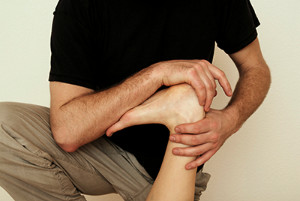
Foot stretches offer a simple yet powerful way to improve flexibility, relieve tension, and prevent injuries. One effective stretch is the toe stretch, where you sit back on your heels, gently pressing your toes into the ground to stretch the top of the foot. Another beneficial stretch is the calf stretch, achieved by placing hands on a wall, stepping one foot back, and pressing the heel into the ground while keeping the back leg straight. Additionally, the plantar fascia stretch targets the sole of the foot, as you sit with one leg crossed over the other, gently pulling your toes back towards the shin. These stretches can alleviate discomfort caused by conditions like plantar fasciitis and Achilles tendonitis, while also enhancing overall foot mobility and function. Incorporating these stretches into your daily routine, especially before and after physical activity. If you are interested in learning more about specific foot stretches and how they can help relieve foot pain, it is suggested that you contact a podiatrist.
Why Stretching Is Important for Your Feet
Stretching the feet is a great way to prevent injuries. If you have any concerns with your feet consult with one of our podiatrists from Sutera and Jones Surgical Podiatry. Our doctors will assess your condition and provide you with quality foot and ankle treatment.
Stretching the Feet
Stretching the muscles in the foot is an important part in any physical activity. Feet that are tight can lead to less flexibility and make you more prone to injury. One of the most common forms of foot pain, plantar fasciitis, can be stretched out to help ease the pain. Stretching can not only ease pain from plantar fasciitis but also prevent it as well. However, it is important to see a podiatrist first to determine if stretching is right for you. Podiatrists can also recommend other ways to stretch your feet. Once you know whether stretching is right for you, here are some excellent stretches you can do.
- Using a foam roller or any cylindrical object (a water bottle or soda can will do), roll the object under your foot back and forth. You should also exert pressure on the object. Be sure to do this to both feet for a minute. Do this exercise three times each.
- Similar to the previous exercise, take a ball, such as a tennis ball, and roll it under your foot while seated and exert pressure on it.
- Grab a resistance band or towel and take a seat. If you are using a towel, fold it length wise. Next put either one between the ball of your foot and heel and pull with both hands on each side towards you. Hold this for 15 seconds and then switch feet. Do this three times for each foot.
- Finally hold your big toe while crossing one leg over the other. Pull the toe towards you and hold for 15 seconds. Once again do this three times per foot.
It is best to go easy when first stretching your foot and work your way up. If your foot starts hurting, stop exercising to ice and rest the foot. It is advised that you then see a podiatrist for help.
If you have any questions, please feel free to contact one of our offices located in Media, Glen Mills, Riddle Memorial Hospital, and Concordville, PA . We offer the newest diagnostic and treatment technologies for all your foot care needs.
Are Bunions Affecting Your Everyday Life?
Importance of Foot Examinations for Older People
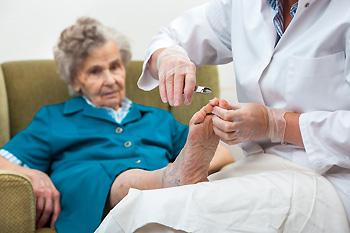 Foot exams are important for older adults, as aging often brings about various foot problems that can significantly impact mobility and increase the risk of falls. Over time, feet undergo changes such as loss of fat padding, reduced blood circulation, and structural alterations, making them more susceptible to conditions like arthritis, bunions, and plantar fasciitis. Additionally, common age-related issues like diabetes can lead to neuropathy and other complications that exacerbate foot problems. Regular foot care becomes more critical with age, as maintaining foot health directly contributes to overall well-being and independence. If self-care becomes challenging, it is essential to seek assistance from caregivers or healthcare professionals to ensure proper hygiene and monitoring. Routine foot exams involve checking for signs of skin breakdown, infections, deformities, and circulation issues. A podiatrist may also assess gait and balance to prevent falls. If you are a senior, it is suggested that you schedule an appointment with a podiatrist for comprehensive foot care, as they specialize in diagnosing and treating foot-related issues.
Foot exams are important for older adults, as aging often brings about various foot problems that can significantly impact mobility and increase the risk of falls. Over time, feet undergo changes such as loss of fat padding, reduced blood circulation, and structural alterations, making them more susceptible to conditions like arthritis, bunions, and plantar fasciitis. Additionally, common age-related issues like diabetes can lead to neuropathy and other complications that exacerbate foot problems. Regular foot care becomes more critical with age, as maintaining foot health directly contributes to overall well-being and independence. If self-care becomes challenging, it is essential to seek assistance from caregivers or healthcare professionals to ensure proper hygiene and monitoring. Routine foot exams involve checking for signs of skin breakdown, infections, deformities, and circulation issues. A podiatrist may also assess gait and balance to prevent falls. If you are a senior, it is suggested that you schedule an appointment with a podiatrist for comprehensive foot care, as they specialize in diagnosing and treating foot-related issues.
If you need your feet checked, contact one of our podiatrists of Sutera and Jones Surgical Podiatry. Our doctors will attend to all of your foot and ankle needs and provide you with quality treatment.
Geriatrics and Podiatry
When people age, some common issues that may occur are bone density loss, dry skin, poor circulation, and rough brittle nails. These issues may also affect your foot health if the necessary steps are not taken to alleviate the problems.
It is important to take care of your feet because feet that are injured or diseased can affect your overall health. Having painful feet hinders your ability to do daily activities or may decrease your willingness to do the things that you need to do.
Visiting Your Geriatrician
As we age, health problems become more likely, so it is essential to visit your doctor for check-ups to ensure that you are doing the best you can to take care of your health. It is recommended to check your feet frequently for any possible cuts, bruises, swelling, corns or any other irregularities.
Taking Care of Elderly Feet
Cracked or dry feet can be treated by applying moisturizer often. It is also important not to wear old socks because the older the sock is, the higher the possibility there will be that there is bacteria there. Wear fresh socks and make sure they fit properly.
Proper foot health means that you can have a more active lifestyle and you will not be bogged down by pain. Foot health also leads to good circulation, which is paramount for overall health.
If you have any questions, please feel free to contact one of our offices located in Media, Glen Mills, Riddle Memorial Hospital, and Concordville, PA . We offer the newest diagnostic tools and technology to treat your foot and ankle needs.
Causes and Dietary Recommendations for Gout
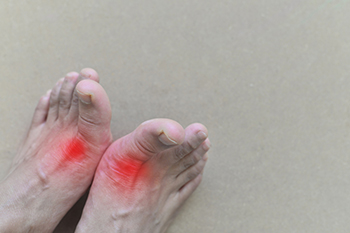
Gout is a type of arthritis caused by high levels of uric acid in the blood, leading to the formation of sharp crystals in the joints. The big toe is often affected, and the pain may become debilitating, some patients have difficulty in walking and completing daily activities. This condition can be triggered by factors such as genetics, obesity, and certain medical conditions. Diet plays a significant role in managing gout. Foods high in purines, such as red meat, organ meats, and certain seafood like sardines and shellfish, should be avoided as they can increase uric acid levels. Additionally, sugary beverages and alcohol, particularly beer, can exacerbate gout symptoms. On the other hand, a diet rich in low-purine foods can help manage gout effectively. These include fruits, vegetables, whole grains, and low-fat dairy products. Drinking plenty of water and maintaining a healthy weight can also help reduce uric acid levels. Individuals who have gout often experience extreme pain and discomfort, especially in their big toe. If this applies to you, it is strongly suggested that you are under the care of a podiatrist who can treat this condition, and lead you to making correct food choices.
Gout is a painful condition that can be treated. If you are seeking treatment, contact one of our podiatrists from Sutera and Jones Surgical Podiatry. Our doctors will treat your foot and ankle needs.
What Is Gout?
Gout is a form of arthritis that is characterized by sudden, severe attacks of pain, redness, and tenderness in the joints. The condition usually affects the joint at the base of the big toe. A gout attack can occur at any random time, such as the middle of the night while you are asleep.
Symptoms
- Intense Joint Pain - Usually around the large joint of your big toe, and it most severe within the first four to twelve hours
- Lingering Discomfort - Joint discomfort may last from a few days to a few weeks
- Inflammation and Redness -Affected joints may become swollen, tender, warm and red
- Limited Range of Motion - May experience a decrease in joint mobility
Risk Factors
- Genetics - If family members have gout, you’re more likely to have it
- Medications - Diuretic medications can raise uric acid levels
- Gender/Age - Gout is more common in men until the age of 60. It is believed that estrogen protects women until that point
- Diet - Eating red meat and shellfish increases your risk
- Alcohol - Having more than two alcoholic drinks per day increases your risk
- Obesity - Obese people are at a higher risk for gout
Prior to visiting your podiatrist to receive treatment for gout, there are a few things you should do beforehand. If you have gout you should write down your symptoms--including when they started and how often you experience them, important medical information you may have, and any questions you may have. Writing down these three things will help your podiatrist in assessing your specific situation so that he or she may provide the best route of treatment for you.
If you have any questions, please feel free to contact one of our offices located in Media, Glen Mills, Riddle Memorial Hospital, and Concordville, PA . We offer the newest diagnostic and treatment technologies for all your foot care needs.
Blog Archives
- April 2025
- March 2025
- February 2025
- January 2025
- December 2024
- November 2024
- October 2024
- September 2024
- August 2024
- July 2024
- June 2024
- May 2024
- April 2024
- March 2024
- February 2024
- January 2024
- December 2023
- November 2023
- October 2023
- September 2023
- August 2023
- July 2023
- June 2023
- May 2023
- April 2023
- March 2023
- February 2023
- January 2023
- December 2022
- November 2022
- October 2022
- September 2022
- August 2022
- July 2022
- June 2022
- May 2022
- April 2022
- March 2022
- February 2022
- January 2022
- December 2021
- November 2021
- October 2021
- September 2021
- August 2021
- July 2021
- June 2021
- May 2021
- April 2021
- March 2021
- February 2021
- January 2021
- December 2020
- November 2020
- October 2020
- September 2020
- August 2020
- July 2020
- June 2020
- May 2020
- April 2020
- March 2020
- February 2020
- January 2020
- December 2019
- November 2019
- October 2019
- September 2019
- August 2019
- July 2019
- June 2019
- May 2019
- April 2019
- March 2019
- February 2019
- January 2019
- December 2018
- November 2018
- October 2018
- September 2018
- August 2018
- July 2018
- June 2018
- May 2018
- April 2018
- March 2018
- February 2018
- January 2018
- December 2017
- November 2017
- October 2017
- September 2017
- August 2017
- July 2017
- June 2017
- May 2017
- April 2017
- March 2017
- February 2017
- January 2017
- December 2016
- November 2016
- October 2016
- September 2016
- August 2016
- July 2016
- June 2016
- May 2016
- April 2016
- March 2016
- February 2016
- January 2016
- December 2015
- November 2015
- October 2015
- September 2015
- August 2015
- July 2015
- June 2015
- May 2015
- April 2015
- March 2015
- February 2015
- January 2015
- December 2014
- November 2014
- October 2014
- September 2014

